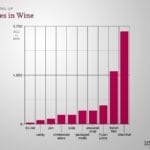Frequently Asked Questions (FAQ)
Store specific
Where are you located?
Address:
What are the store hours?
Business Hours:
| Tue – Fri: | 3:30p – 7:30p |
| Sat: | 9:00a – 2:00p |
| Sun & Mon: | CLOSED |
What is the cost of a full kit?
The complete process, which includes a juice kit, instruction & processing on-premises, bottles, corks, caps, standard labels, and tax starts at $190.00 (prices subject to change). This will make approximately 30 bottles of fine wine. (That price includes everything EXCEPT bottles. You can save about $35 by re-using your own bottles.)
Can I do my own labels?
We’ve got a post that details a bunch of these options, including some samples, here.
- To download some free software to run on your own machine, check out the Avery download site.
If you want us to print them (which we’re happy to do, for an $8 fee), we use the labels which correspond to Avery template 5164 (2 x 3 – 6 per page).
Are gift cards available?
Gift certificates are available for amounts of $25.00 and up and are for use in our store. Why not pick up a card for a friend or loved one (and maybe one for yourself)?
Gift certificates are great ideas for:
- Valentine’s Day
- Mother’s Day
- Holidays
- Weddings
- Anniversaries
- Birthdays
- Anytime that you require “the perfect gift”
Are there discounts available?
Secondary Fermentation
- If you start another wine kit on the day you bottle, we’ll take 10% off the price of your kit.
Bring a Friend
- If you bring in someone to start a new batch (and they’ve never done a batch themselves with WBD), AND they start a batch of their own, we’ll reward you with $20 off of your batch. (You can share it with them or keep the $20 for yourself, your choice!)
Wine Making
What does the Bentonite do to the wine?
What does the Metabisulphite do to the wine?
What does the Potassium Sorbate do to the wine?
Can I leave the sulfites out of my wine?
Additionally, yeast actually make sulphites themselves during fermentation, so no wine can ever be sulphite-free, no matter what.
Without added sulphites the kit will oxidize and spoil very rapidly. It will start to go off in less than 4 weeks, and be undrinkable in less than three months. Also, if the sulphite is left out, but the sorbate is added, the wine will be attacked by lactic bacteria, which will convert the sorbate into the compound hexadienol, which smells like rotting geraniums and dead fish.
As a result, Wines By Design STRONGLY recommends adding the prescribed sulfites to your wine kits.
Bottom line: If you do not add the sulphite to the kit, neither Wines By Design or a manufacturer of a wine kit can guarantee the wine, so think carefully before you do it.
FYI: Per our manufacturers, the sulfites added to our wine kits will result in approximately 16-50ppm of free SO2 at bottling.

An image (from the article below courtesy of our friends at Wine Folly) comparing the amount of sulfites in a dry red wine to other foods can be found.
Original Source: The Bottom Line on Sulfites in Wine.
Is there shellfish in my wine?
Thank you for your contact and for choosing our products. Although the raw material for chitosan is derived from shellfish, the way it is processed completely destroys all proteins. The shells are ground to a fine powder and soaked in sodium hydroxide (essentially lye, the same ingredient in oven cleaner that breaks down the proteins in the material on the wall of a dirty oven). It is processed three times to achieve the grade that we use as a fining agent. What is left is actually a long-chain polysaccharide, a form of sugar that is so complex that it resembles polyester more than actual table sugar.
This process degrades _all_ of the protein in the shells. Proteins are the compounds that cause the allergic reaction in human beings: no protein, no reaction.
The material is so safe that it is currently used in water treatment facilities across Canada and the world: you may have already consumed some. It is even sold as a dietary supplement (it absorbs certain fats in the digestive system, and some people believe it helps with weight loss).
So the chitosan is completely safe.
Can I use my own bottles?
But we’d really like you to make sure that you clean them correctly!
Please check out our bottle cleaning post.
Something missing from our FAQ?
Please let us know via our Contact page!